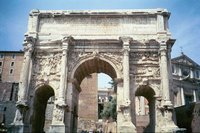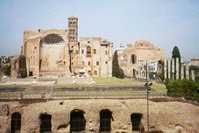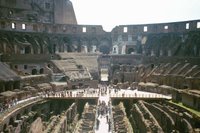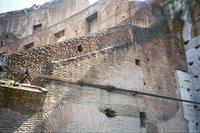

When I started High School I found, rather to my surprise, that I was taking Latin for the first three years. I was hopeless at it; mercifully our teacher gave up in the third year and took to playing bag-pipes to the class and reading passages to us from "the Compleat Molesworth" by Ronald Searle of St Trinians ' fame.


He probably agreed with the ditty in the fly-leaf of my Latin Primer from a long-ago student:
Latin is a language
As dead as dead can be
It killed the Ancient Romans
And now it's killing me.
I did enjoy the Roman History segment - but detested translating "Caesar's Gallic Wars".
Oddly, many years later I came across an English translation - and found it fascinating.
Each time I came across evidence of the Ancient Romans I was awed at their civilisation - their technology and their culture, despite it's savagery by modern standards (well, most modern standards) was simply far ahead of the following thousand years. A salutary lesson for all cultures that allow corruption and complacency to become the cancers that destroy a great culture.
I later saw Roman ruins in many places - Pompeii, Greece, Istanbul, Pont-du-Gard, Aquileia, Trier and many others - but the pinnacle to me was undoubtedly the Forum and Colosseum.
The remains are from a period of nearly 800 years or more, from 5th or 6th century BC to 3rd century AD.
The Forum is simply too big to give much detail here. I'll let the photos tell most of the story.
The Colosseum was completed in 80 AD only nine years after construction commenced - something that is impressive even today. Imagine the cost and complexity of building a stadium today to hold 80000 spectators, with walls 50m (about 17 stories) high, with a full underground system of chambers, able to be flooded for mock naval battles and drained for other (usually deadly) shows, and covered in inclement weather. Then face it all with marble.
Sitting in the gallery, I gazed at this underground system and pondered on those who had sat below the surface about to face death; I doubt that I could have stopped the knees shaking as I faced Caesar and said "ave, Caesar, morituri te salutamus" - hail, Caesar, we who are about to die salute you.
Sadly, much of it disappeared as the centuries passed; over the years it became a cemetery, then a fortress, and worst, after the 1349 earthquake, a quarry for building materials. Yet, after all that the ruins are still one of the wonders of the world. The quality of the workmanship by the bricklayers and architects is wonderful - look at the detail and keep reminding yourself it's 2000 years old. I wish my house was built that well.
Cheers, Alan









No comments:
Post a Comment